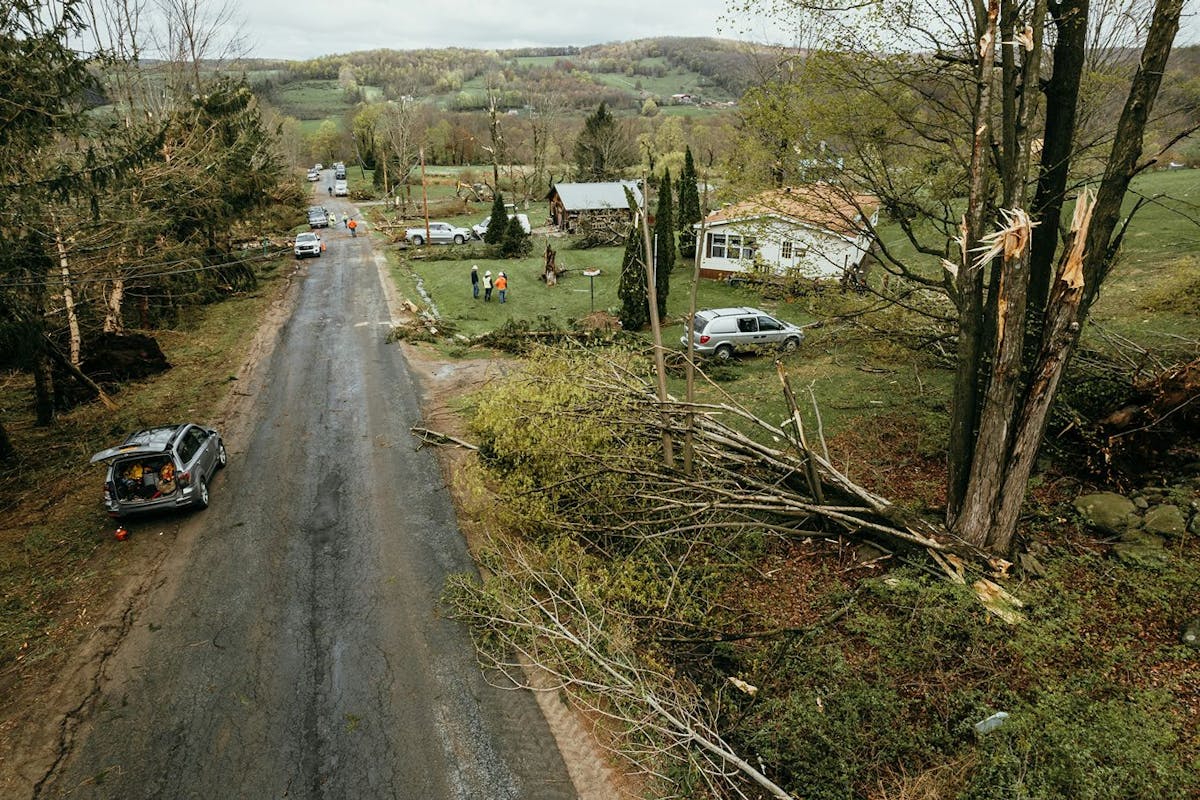Prepare Your Home and Solar Panels for a Storm: 32 Essential Tips
Last edited

Author
Andrew Giermak
Solar and Electrification Writer and Editor

Editor
Andrew Blok
Electrification and Solar Writer and Editor

Late summer and early fall means the brunt of hurricane season in the southeast US and Texas. Some areas of the country are nearly always on alert for tornadoes or have the chance of winter weather for four to six months of the year. Then there’s wildfires and droughts increasing in frequency due to climate change.
While preparing your home for a storm is no guarantee of safety — and you should always follow the warnings of local officials — it can help increase your chances of avoiding a costly repair. If you’ve made an investment in home solar panels, protecting your system could prove important in bad weather or a disaster. Here are maintenance and preparation tips that could limit storm or weather damage.
See how much you can save with home energy changes
What Happens to Solar Panels in a Storm?
While it’s normal to worry about your solar panels during bad storms, they are designed to withstand most forms of bad weather. Solar panels are waterproof and built to last for 25 years or more. They will continue generating energy as long as they can absorb sunlight.
Additionally, the quality of your installation services and your roof’s condition determine the ability of your solar panels to withstand extreme weather. If a professional solar company installed your solar power system and your roof is in good condition, your solar panels should be okay.
Exceptions happen though, so you should invest in a maintenance plan, and know if your panels are covered by your homeowners insurance. You should also review your solar panel warranty to see what types of repairs and coverage are included.
Preventative maintenance can help limit or reduce the likelihood of damage, but no amount of preparation is a guarantee that a storm won’t harm you, your home, or your solar panels. Always take into account the best advice of local experts.
Preventing Storm Damage With Basic Household Maintenance
When it comes to active storm damage prevention, we recommend incorporating prevention steps into basic household maintenance.
- Clean your gutters: Keeping your gutters free of debris is the first line of defense against heavy storms. Clean them regularly to ensure water drains away from the house. Consider installing gutter guards to make maintenance easier.
- Clear leaves off your roof: Use a roof rake, strong blower, or broom to remove dead leaves from your roof to allow the free flow of water and prevent flooding during heavy rains.
- Cleaning solar panels: Solar panels don’t need frequent cleaning or maintenance. Simple rinsing or cleaning can be a good idea ahead of expected severe weather or to help efficiency. Rinsing with a garden hose from ground level will rinse dust, leaves, or dirt off panels sufficiently.
- Clean your downspouts: Clogged downspouts can lead to water damage. Remove debris at the openings where the gutters feed into them, check for blockages, and rinse them with a hose.
- Take care of your yard: Keep your grass short and regularly remove dead vegetation from your yard to help prevent flooding or loose branches or debris being blown.
Seasonal Maintenance for Storm Damage Prevention
Extreme weather events can cause roof damage, flooding, broken windows, and downed trees. These seasonal tasks can help you limit or prevent storm damage.
- Inspect your sump pump: If you have a sump pump, you need it to work at a moment’s notice. Consider installing a battery backup if your area is prone to power outages during high winds and heavy rainfall.
- Check the seals on your windows: Tap the glass window panes to see if they rattle or move. You can also feel drafts by holding a damp hand around the window seals.
- Check the seals on your doors: Check the weatherstripping around the doors to ensure it is intact and does not allow outside air in.
- Check for loose siding: Since siding can be split, loose, or cracked from age or previous wind damage, a professional inspection can help you know whether you need to replace the entire siding or individual sections before storm season.
- Check for loose shingles: Wind-driven water can work its way under missing or faulty shingles, so you should contact a roofing professional for a thorough inspection.
- Check your fence posts: Inspect the stability of your fence by giving each post a good shake, since the ones that aren’t secure can topple over with strong winds and become projectiles in a hurricane.
- Check trees and branches: You don’t want wind, ice, or rain to make limbs fall on your home. Check your trees regularly, and cut down any dead or dying foliage.
- Inspect your chimney: Ensure your chimney flashing is in good condition and you can tightly close the chimney when necessary to protect your home from water damage. Signs like leaking from the outside or inside of the chimney, or water stains on the interior of the ceiling call for repair.
How to Prevent Storm Damage With Annual Projects
Once a year, do some vital maintenance for storm damage prevention. Some of these projects are best done professionally.
- Review your homeowner's insurance policy: This should be the first stop on your annual home maintenance checklist. Ensure your insurance policy provides the coverage you need, or think the policy covers, before you have to file a claim.
- Check your foundation: Previous flooding, bad winter weather, or long-term degradation of concrete can lead to structural damage, so it's best to contact a qualified expert for examination and repairs.
- Check for drainage problems: Review your home’s entire drainage system, as standing water and debris can harm your roof and foundation during hurricanes and other major storms.
- Inspect your roof: An annual roof inspection can catch issues before they become major issues.
- Install wildfire-resistant landscaping: Wildfires are extremely damaging to the property and environment, so you should plant moisture-rich foliage and install landscaping materials such as stone, brick, or cement to create a defensible space zone.
- Increase your protection against wildfires: Remove any accumulated vegetative debris and consider using home hardening techniques for roofs, vents, and windows.
- Inspect your generator: A bad storm could potentially lead to a blackout for hours or days, so you need your generator in reliable working condition to protect your food and the livability of your home until power is restored. Even better, consider switching to a battery storage instead of a backup generator for greener, cleaner backup power.
- Install storm shutters: Heavy rains and strong winds can damage your windows, so impact-resistant shutters can help protect your windows against extreme conditions.
- Seal basement walls: Applying a basement sealer can prevent flooding and leaks during hurricanes. Many such solutions are do-it-yourself, although a few may require professional help.
See how much you can save with home energy changes
How to Protect Your Home as a Major Storm Approaches
If a potentially devastating weather event is approaching your area, you can prevent storm damage and ensure the safety of your home and family by completing key tasks a few days in advance.
- Secure your outdoor furniture: Pack away all your outdoor decorations and lawn furniture to prevent them from being damaged, or becoming projectiles, in a severe storm. If you can’t bring large items indoors, tie them down as best as possible.
- Secure furniture that could fall: To prevent tall, heavy furniture like cabinets or bookshelves from falling, anchor them securely and move them away from windows and doors.
- Know how to shut off your utilities: Severe weather can cause power surges and ruptured water and gas lines. Locate all your cutoff valves and switches and know how to turn them off in the event of an emergency.
- Identify safe rooms in your home: As part of your overall prevention plan, your family should know the safest room in the house, usually an interior room without windows.
- Move the cars to safety: Windblown debris during hurricanes and tornadoes can damage your car, so park inside your garage and close the garage door. If you do not have a garage, park your car close to your home on the leeward side of the wind and keep it away from trees and power lines to reduce the risk of damage.
- Secure your plants: Move all potted plants inside the house or garage, and create a small temporary indoor garden where you can take care of them.
- Secure all essential home-related documents: Create a visual or digital record of your home, possessions, and important documents using pictures, videos, or files for insurance purposes.
- Keep your electronic devices charged. Focus on communication devices in case the power is out after the storm passes. You could have battery packs or a 12-Volt battery charger to charge devices in a car during a blackout.
- Create a disaster kit: A disaster kit comes in handy during hurricanes, wildfires, or drought, so you should assemble one with essentials like first aid, nonperishable foods, water, and gear that doesn’t require electricity.
- Have an evacuation plan: Your family must have a clear idea of what they should do in case a hurricane, wildfire, or other severe storm forces an evacuation, including what to take, where to travel, and how to communicate if you’re separated.
Tips for Storm Damage Prevention
While you can't control the weather, you can protect your family and home with preventative measures and having an emergency plan.
Break down the tasks into checklists by need and season so you don’t get overwhelmed by the amount of work. If you aren’t sure how to prevent storm damage by yourself, talk to professionals, as they are trained to take care of the larger tasks and do them properly.
For more about going solar, saving money, and increased energy independence for your home, you can use our solar savings calculator to learn more.
See what home electrification can do for you:
Frequently Asked Questions
Can solar panels survive severe weather?
Solar panels are built and installed to be very durable and last through severe weather. They are typically under warranty forf 25 years or longer. In recent years, solar panels have survived, and returned to generating power very soon after, hurricanes in New Jersey, Puerto Rico, the Carolinas, and Florida.
Will solar panels keep my home powered through an outage?
Solar panels that do not have a backup battery attached will not give your home electric power in a power outage. If you have backup battery storage, your system will be able to give you power and keep generating new electricity once sunlight can reach the panels. That can be a much shorter span than it takes for the utility grid to be restored.


